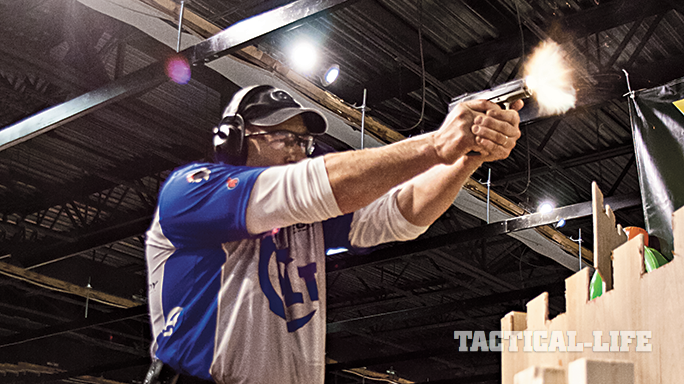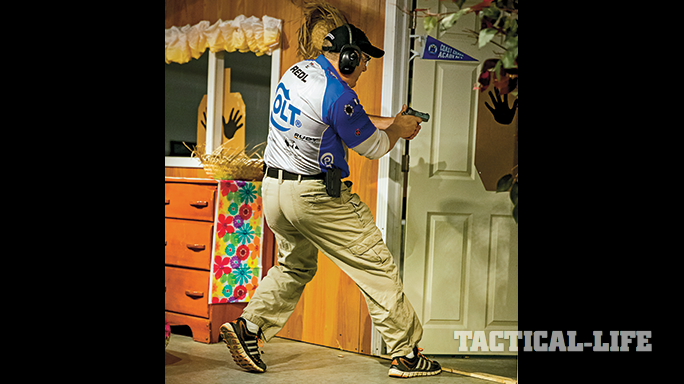For the second year in a row, Colt-sponsored shooter Mark Redl earned the King of New England title by winning the Custom Defensive Pistol division in three separate International Defensive Pistol Association (IDPA) competitions: the Massachusetts State Championship, the New England Regional and finally the Live Free or Die New Hampshire State Championship.
We sat down with Redl to better understand how he maintains his championship form on and off the range.
How did you get started in competitive shooting?
Advertisement — Continue Reading Below
I was granted my New York State carry permit in the 1980s. I realized that I had no formal training in firearms safety or marksmanship. The local gun shop where I purchased my firearms was operated by retired Special Forces personnel and we became friends. They were my mentors and got me started in the proper use of firearms.
I then began a journey of attending defensive training schools throughout the country. I realized most of the skills I learned for the pistol were perishable and I needed to find something to help keep the skills current. I started shooting USPSA. When I read an article about IDPA and that Ken Hackathorn was a founding member, I contacted him and got involved right away. My membership number was 11. I soon moved up to a life membership, and now my son’s membership number is 11.
After I earned my Master classification, I was talking to Dave Sevigny and he explained I could stay a Master or work hard and become a High Master, one of the top shooters in the country. That was around 2001, and I really started to train and study action shooting.
Advertisement — Continue Reading Below
Do competitions help hone real-world defensive skills?
There have been many conversations about competition versus the real-world defensive use of firearms. My opinion is that competition shooting is a great way to learn safe gun-handling skills. At every stage you load, move, reload and unload safely under the watchful eye of a safety officer. All of the competitors that I know are much safer and more educated in the proper use of the firearms they own.
What is your dailyweekly training routine?
Advertisement — Continue Reading Below
I own and manage a couple of family businesses. Most shooters today have real-world jobs and must find the time to train and travel to matches. My work day is usually get up 5:00 a.m., go to the gym, come back and do my reloading for practice or matches, then try to get 15 to 30 minutes of dry firing. My live-fire training is usually one night a week and weekends.
To get the most out of my training, I need to know where I must improve. I learn this by breaking down the matches I shoot. I break each stage down right after the match, to see where I am lacking. Everyone wants to practice what they are good at in order to feel good. The more successful competitors look at their weaknesses and train to make them a strength.
What equipment do you use for competition and EDC?
Advertisement — Continue Reading Below
For the King of New England series, I shot a Colt Combat Elite with a National Match barrel, a Novak rear sight and fiber-optic front sight, an upswept beavertail grip safety with palm swell and VZ grips. I also include a tactical mag release and flat trigger. I load my own ammunition using Delta Precision bullets, Hodgdon powders and Federal primers. I also use Comp-Tac holsters and pouches. For my personal concealed carry, I prefer the Colt Lightweight Commander or Defender with an IWB holster I made myself. All of my carry guns are .45 ACP, and my match guns are 9mm or .45 ACP.
Are you just a pistol guy?
No. I love to shoot clay birds, sporting clays, skeet and five stand. I will also train for 3-Gun matches with my AR-15 and shotgun. I have just started to get into long-range rifle shooting.
Advertisement — Continue Reading Below
What is the most important consideration for your gear?
As a competition shooter and a CCW holder, there are three things my equipment must have. First is durability. My firearms must be able to withstand large numbers of rounds without breaking. My match gun has over 130,000 rounds through it, and it can still hold a 3-inch group at 25 yards. Second is reliability. If your gun does not go bang every time you pull the trigger, you can’t win matches, and in the real world you will not survive. Third is consistency. The firearm you use must fit you and your style of shooting. Every time you bring the pistol up on target, it must be within an acceptable hit zone.
What advice would you have for a newcomers?
Advertisement — Continue Reading Below
Look for some action shooting matches in your area and go watch. Just about all of the competitors started at the bottom, and they are a wealth of information to help you get some good equipment and learn how a match is run. Don’t be afraid to ask questions. It is also important to read the rule book and learn the range commands.
At first, go out have fun and be safe. If you want to really improve and move up the ladder in competitive shooting, you must be ready for sacrifices. I have spent many hours at the range training and shooting local matches—that means time away from your family. Every time you go to the range, it is for the purpose of training. The days of developing bad habits are over.
What are your top three tips for getting race ready?
Advertisement — Continue Reading Below
Be prepared. I go through my guns totally before a major match, checking all the parts. I chamber check and visually inspect all of my match ammo as well. I go over all of my gear to make sure nothing has shifted or needs replacing, and finally I make a list of everything I need for the match so I don’t forget anything.
Second, I make sure to keep a complete and thorough training log with as much information in it from my training sessions.
Lastly, this year, the best tip I got was from my wife. She reminded me of why I started competing. I really love shooting and the camaraderie. This year, I took that advice and was very relaxed at all of my matches and really enjoyed myself.
Advertisement — Continue Reading Below
- RELATED STORY: Gun Test: Colt’s M.A.R.C. 901 Series of AR Carbines
This article is from the August 2015 issue of COMBAT HANDGUNS. To subscribe or to read more from this issue, please visit PersonalDefenseWorld.com.

























